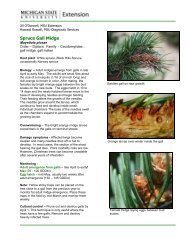Integrated Pest Management for Christmas Tree Production: A ...
Integrated Pest Management for Christmas Tree Production: A ...
Integrated Pest Management for Christmas Tree Production: A ...
Create successful ePaper yourself
Turn your PDF publications into a flip-book with our unique Google optimized e-Paper software.
CLIPBOARD/FLAT SURFACE<br />
Hold a clipboard or another fl at surface<br />
under a branch to collect mites, aphids,<br />
or other insects dislodged by tapping the<br />
branch (Fig. 15). The back of a clipboard<br />
that has been painted to have one half<br />
black and one half white is very useful when<br />
beating trees to detect pests. The inside<br />
back cover of this manual is a good fl at<br />
surface to use.<br />
PRUNERS/POCKET KNIFE<br />
Growers may need to clip symptomatic<br />
twigs or branches to observe them more<br />
closely <strong>for</strong> signs of insects, mites, or disease<br />
spores. Collecting samples <strong>for</strong> identifi cation<br />
by a diagnostic expert (Fig. 16) may also be<br />
necessary.<br />
BOTTLES/PLASTIC BAGS<br />
Occasionally, growers need to collect samples<br />
to examine at a later date or send to a<br />
diagnostic laboratory. In addition to bottles<br />
and plastic bags <strong>for</strong> collecting samples,<br />
having a method of labeling the specimens<br />
(permanent marker, adhesive labels, etc.) is<br />
also helpful. Any sample collected in alcohol<br />
should be labeled with a pencil-written<br />
tag inserted into the vial.<br />
Monitoring Tips<br />
1. During the growing season, a scout<br />
should be monitoring fi elds weekly to<br />
look <strong>for</strong> evidence of pests, diseases, and<br />
other problems.<br />
2. If possible, scout on cloudy days. The<br />
muted sunlight makes it easier to observe<br />
chlorotic, or yellowed, symptoms<br />
in the fi eld. Some pests are also more<br />
visible in subdued light.<br />
3. When monitoring blocks <strong>for</strong> problems,<br />
scouts should walk through the fi eld<br />
while keeping an eye out <strong>for</strong> obvious<br />
problems. They should also select nonsymptomatic<br />
trees in a random pattern<br />
to inspect more closely. For these trees,<br />
be sure to look at the inside <strong>for</strong> discoloration.<br />
4. Prune a few twigs from the interior<br />
and lower portion of the tree <strong>for</strong> closer<br />
inspection.<br />
5. Tapping branches over a fl at surface<br />
will dislodge insects and mites, making<br />
them easier to see (use the tapping<br />
sheet at the back of this manual).<br />
Trapping<br />
Several types of insects can be monitored<br />
using traps. The traps are usually baited with<br />
pheromones (insect-produced attractants)<br />
or other chemicals (Fig. 17) and placed in<br />
the fi eld. They are designed to hold the<br />
insect until the trap can be checked by<br />
a scout. When monitored regularly, the<br />
collection data can help with the timing<br />
of control applications. Traps are used <strong>for</strong><br />
monitoring purposes, not control. For more<br />
in<strong>for</strong>mation on trapping, see Appendix E.<br />
Sticky cards are another type of monitoring<br />
tool used to trap insects. These<br />
adhesive-coated index cards, which come<br />
in various sizes and colors, may be used<br />
to monitor the emergence of small pests<br />
(Fig. 18). For example, in the case of some<br />
scale insect pests, 3-by-5-inch sticky cards<br />
are used to attract the adult male life stage.<br />
The cards are attached with clothespins<br />
to scale-infected tree limbs be<strong>for</strong>e the<br />
expected time of emergence. Cards can<br />
then be monitored regularly.<br />
Figure 18. Yellow sticky cards used to trap<br />
fl ying adult male scales. Courtesy of Cathy<br />
Thomas, PDA<br />
Diagnosis<br />
Proper identifi cation of the pests that<br />
have been found through the monitoring<br />
process is an important next step in the<br />
pest management process. With training,<br />
experience, and the use of printed and Web<br />
resources and guides, growers or scouts can<br />
usually make an accurate diagnosis. For<br />
diffi cult samples, consult an expert or a<br />
diagnostic lab. Regional inspectors <strong>for</strong> the<br />
state department of agriculture and county<br />
extension educators can be very helpful in<br />
obtaining necessary expert assistance. For<br />
contact in<strong>for</strong>mation <strong>for</strong> select agencies, see<br />
Appendix K.<br />
Figure 15. Tapping branches<br />
over a white notebook or fl at<br />
surface to dislodge and observe<br />
pests. Courtesy of Brian Schildt,<br />
PDA<br />
Figure 16. A good set of pruners.<br />
Courtesy of Joseph O’Brien,<br />
USDA Forest Service, Bugwood<br />
.org (#5044044)<br />
Figure 17. White pine weevil<br />
trap. Courtesy of Cathy Thomas,<br />
PDA<br />
IPM BASICS ............................................................................................................................................................................................................................................................................................ 11





